Feverfew (Tanacetum parthenium), also known as Altamiza, Bachelor’s Buttons, Wild Chamomile, and several other names, is a versatile perennial plant from the Asteraceae family. Native to Southeastern Europe, Central Asia, and the Western Himalayas, this species thrives in a range of climates and offers both ornamental and practical value.
With its delicate daisy-like flowers and ability to complement other plants in the garden, feverfew is not only visually appealing but also low-maintenance. Whether you’re a seasoned gardener or just starting out, feverfew is a reliable addition to your garden that requires minimal effort to grow successfully.
In this guide, we’ll explore all you need to know about cultivating feverfew, from its origins and characteristics to the best care practices for a thriving garden.
| Common name | Altamiza, Bachelor’s Buttons, Feverfew, Maids, Manzanilla, Mid Summer Daisy, Pale Maids, Pellitory, Wild Chamomile |
| Botanical name | Tanacetum parthenium |
| Family | Asteraceae |
| Species | parthenium |
| Origin | Southeastern Europe to Central Asia and West Himalaya |
| Life cycle | Perennial |
| Plant type | Perennial |
| Hardiness zone | 5, 6, 7, 8 |
| Sunlight | Full Sun |
| Maintenance | Low |
| Soil condition | High Organic Matter |
| Soil ph | Acid |
| Drainage | Well-Drained |
| Growth rate | Fast |
| Spacing | Less than 12 in. |
| Harvest time | Fall |
| Flowering period | Summer |
| Height | 1 ft. – 3 ft. |
| Flower color | Gold, Yellow |
| Leaf color | Green |
| Fruit color | Brown, Copper |
| Stem color | Green |
| Leaf benefit | Fragrant |
| Flower benefit | Showy |
| Garden style | Cottage Garden |
| Uses | Container |
I. Appearance and Characteristics
Tanacetum parthenium, known as feverfew, is a flowering plant in the daisy family, Asteraceae. It may be grown as an ornament, and may be identified by its synonyms, Chrysanthemum parthenium and Pyrethrum parthenium. It is also used as a herbal medicine in the traditional sense and a dietary supplement to treat headache and other ailments, as well more recently in topical skin care as an antioxidant.
Feverfew is native to Eurasia, specifically the Balkan Peninsula, Anatolia, and the Caucasus, but cultivation has spread it around the world and the rest of Europe, North America, and Chile.
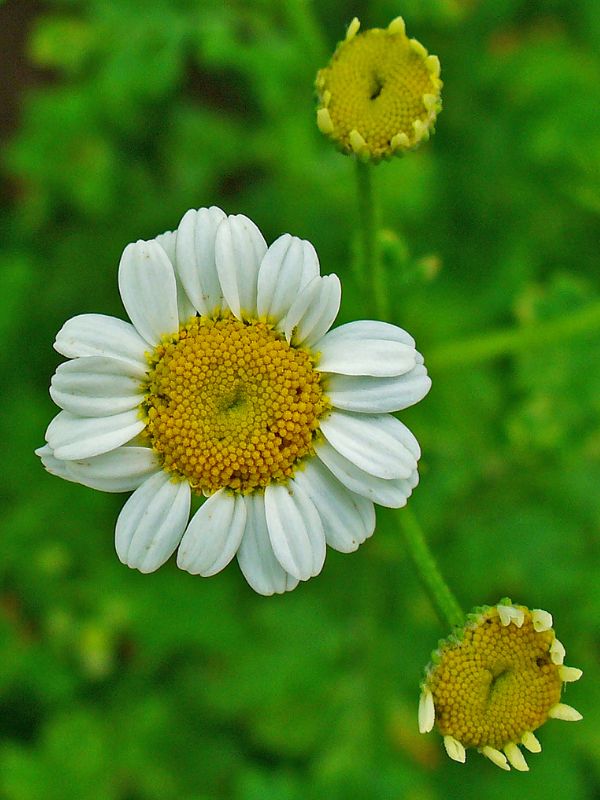
A perennial herb, it should be planted in full sun, 38 to 46 cm (15–18 in) apart, and cut back to the ground in the autumn. It grows up to 70 cm (28 in) tall. It is hardy to USDA zone 5 (−30 °C or −22 °F). Outside of its native range, it may become an invasive weed.
The plant is a herbaceous perennial that grows into a small bush, up to 70 cm (28 in) high, with pungently-scented leaves. The leaves are light yellowish green, variously pinnatifid. The conspicuous daisy-like flowers are up to 20 millimeters (3⁄4 in) across, borne in lax corymbs. The outer, ray florets have white ligules and the inner, disc florets are yellow and tubular. It spreads rapidly by seed, and will cover a wide area after a few years. The plant produces achene fruit, and grows in stony slopes and river beds.
II. How to Grow and Care
Sunlight
Feverfew prefers full sunshine, but tolerates partial shade. Plants grown in part shade may not flower as profusely or aromatically.
This herb is a long-day plant, which means that the amount of sunshine directly impacts the flowering cycle. Plants typically start blooming around the summer solstice when the days lengthen.
Because of its love for sunshine, indoor plants tend to get leggy and unhappy. Feverfew is also fairly hardy, so there is no reason to waste your indoor growing space. This herb will flourish in outdoor patio containers.
Climate and Temperature
Feverfew thrives in warm weather and sunshine. It can be grown as a perennial in zones 5 through 10, or an annual in colder zones. In its dormant state, a well-rooted plant can tolerate a whopping -20°F. During the summer, the herb prefers cozy temperatures in the 70s and 80s.
Seeds germinate best when soil is around 70°F. Indoor sowing and transplanting tends to be best for cut flower varieties of feverfew. Wild types don’t mind direct seeding after the chance of frost has passed.
Watering
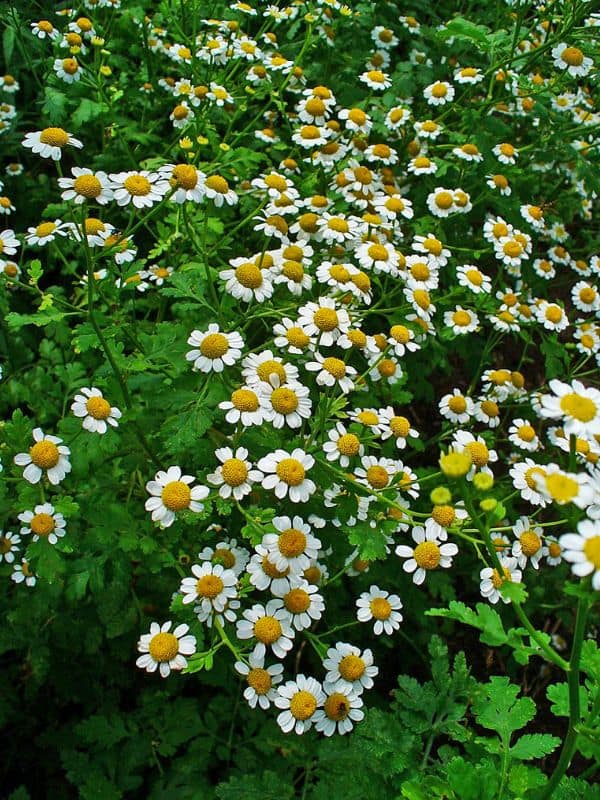
Feverfew prefers consistently moist soil. It does not tolerate long periods drought. The plant grows best in slightly damp soil that is never bone-dry nor overly soggy.
If you don’t get much summer rain, it’s best to mulch your feverfew plants with chopped leaves or a layer of compost. You may need to irrigate 1 to 3 times per week during dry spells. Soil with high amounts of organic matter requires less irrigation because it holds onto moisture.
Soil
Feverfew prefers light, fluffy soil that is well-drained and regularly moist. Heavy clay soils need to be loosened with a broadfork or digging fork and amended with decayed organic matter. Sandy soil will probably need compost or leaf mold to improve the water holding capacity.
A pH between 6.0 and 7.2 ensures proper mineral absorption for this herb. If your soil is too acidic, amend with compost, limestone, or wood ashes.
Fertilizing
Feverfew enjoys a fertile soil that is rich in organic matter. A quality compost should provide plenty of nutrients. In poor soils, you can amend with small amounts of all-purpose, slow-release fertilizer.
Like many herbs, its best to avoid feeding high-nitrogen fertilizers. Too much nitrogen can cause the plant to grow excess foliage with less flowers. Overfertilization also reduces the pleasant smell of the flowers.
Planting Instructions
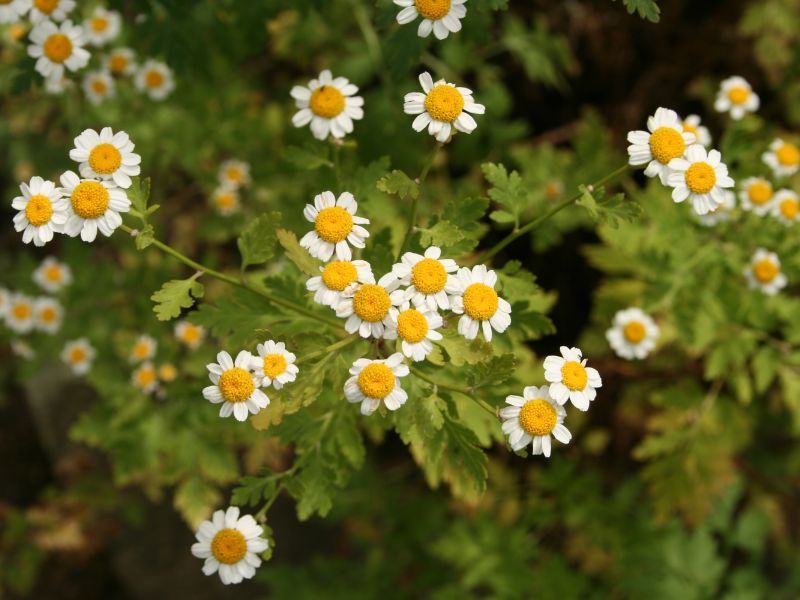
Feverfew is best planted in the spring or early fall. Sow seeds about 2 weeks before your last frost. Alternatively, you can divide and transplant this herb in the late summer or early fall. Be sure it has at least 4-6 weeks to get established before cold weather sets in. In mild climates, feverfew overwinters well and provides extra early flowers.
Propagation
Thanks to its wildflower nature, feverfew is insanely easy to grow from seed, cuttings, or root divisions. Once established, the plant will readily self-sow and slowly spread via underground runners. While feverfew is eager to spread, it is not typically invasive. Unwanted seedlings are easy to pull out.
From Seed
For most gardeners, the best time to plant feverfew is in the spring, as soon as the soil can be worked. You can also start the plant indoors and transplant seedlings outside around the first frost.
Feverfew is somewhat hardy once established, but it is tender as a seedling. When I worked on cut flower farms, we sometimes transplanted feverfew in the fall to achieve longer stems and earlier blooms for spring bouquets. However, overwintering the tender perennial plants requires the extra labor of covering them with row fabric or planting in a greenhouse.
The ideal seeding dates are:
- Spring direct sowing: 1-3 weeks before last frost date (as soon soil is workable)
- Spring transplanting: Sow 5-7 weeks before last frost
- Fall transplanting: 3-4 weeks before first frost
To grow the best feverfew seedlings, remember to:
- Sow feverfew shallowly
The most important thing to remember when seeding feverfew is: Do not cover the seeds! These tiny seeds require light to germinate and should be sown very shallowly. You can use a mister or a very light stream of water to maintain soil moisture without disturbing the seed placement.
If you are direct sowing outside, you can broadcast the seeds into bare soil. This mimics nature’s process for spreading feverfew. Ensure that the area is thoroughly weeded to prevent grasses or other plants from outcompeting the feverfew seedlings.
- Germination time and temperature
Feverfew takes 7-14 days to germinate and enjoys a mild soil temperature of around 70°F. However, it can tolerate colder when directly sown in the garden. A layer of row cover can help encourage more even germination in cold climates, but it usually isn’t necessary.
Keep feverfew seeds continuously moist until the plants develop their first true leaves. As long as seedlings receive 6-8 hours of direct sunlight, there is no need for a germination heat mat or artificial lighting.
- Don’t forget to thin
You can broadcast (sprinkle) the seeds or sow a couple of seeds every 8-12”. Once plants develop their first true leaves, it is essential to thin the seedlings to 1 plant every 8-12”. If growing as a perennial, it’s best to give each plant about 12” of space in every direction.
Overcrowded feverfew can lead to weak, unsightly plants. The individual thinned plants will end up mounding and bushing into each other to create an attractive continuous display.
By Cuttings
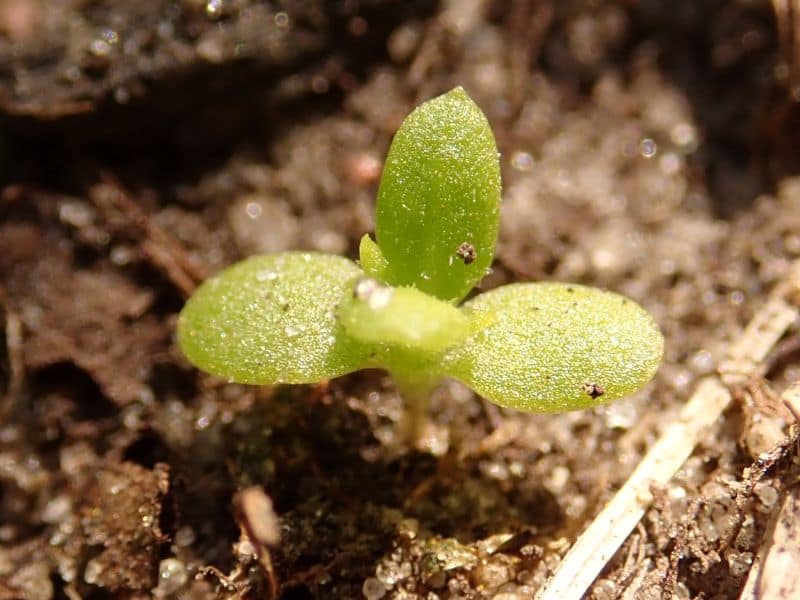
Softwood cuttings are another quick way to start a feverfew patch. If you or a friend already has a thriving feverfew plant, you can take a few stem clippings and root them to replicate the plant.
- Use a strong, healthy feverfew plant.
- Find a 4-6” long, non-flowering stem.
- Use sanitized shears to cut the stem just below a node (the point where the leaves meet the stem).
- Strip the lower 2-3” of leaves.
- Optionally, dip the bottom of the cutting in a rooting hormone.
- Place the cutting in a jar of water or potting mix. Only the lower 2-3” should be submerged.
- Place in a warm, sunny area with bright indirect light.
- Regularly change the water and maintain continuous moisture.
- Wait 1-2 weeks until you see roots form, then transplant to a pot.
Feverfew cuttings root the best in warm soil, so a heating mat can increase your chances of success.
By Division
Due to the clumping nature of feverfew plants, they are very easy to divide. Division is as simple as digging up the plant and cutting the rhizomatous crown into a few chunks. The steps are as follows:
- Divide feverfew in the spring or fall, before or after flowering.
- Find a mature, thriving feverfew plant.
- Use a sharp-edged shovel to dig a circle around the plant, a few icnehs wider than its circumfrence.
- Dig about 1 foot deep.
- Lif the plant from the ground.
- Use the shovel to chop the rhizome into several chunks.
- Each chunk should be at least 6-8” in diameter.
- Replant one chunk in the original space and backfill so only leaves are exposed.
- Transplant the remaining divisions to pots or other parts of your garden.
- Provide at least 12” of space in all directions.
Pests and Diseases
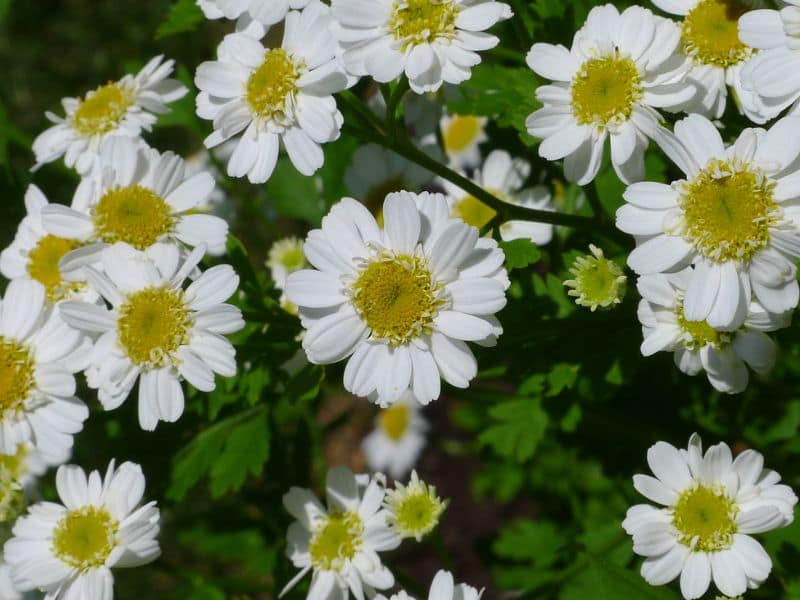
Feverfew is naturally resilient to common garden pests and diseases. The only issue you may have are aphids (they seem to eat everything, don’t they?)
If you notice aphids crawling on this white and yellow beauty, a heavy stream of water can usually knock them off. In extreme infestations, throw away affected plant parts and treat the herb with a diluted neem solution.
Maintenance
Aside from consistent irrigation, feverfew is relatively maintenance-free. If growing feverfew is a perennial, you can cut it back to the ground after the first hard frost. The plant will regenerate in the spring with fresh, attractive new growth.
Feverfew is a self-seeding plant that can spread quickly in its optimum conditions. While it’s unlikely to take over your garden, it may require some weeding. Unwanted seedlings are easy to pullout. Clumps should be divided annually to prevent them from getting out-of-hand.
III. Uses and Benefits
- Ornamental uses
Feverfew (Tanacetum parthenium) is a very common herbaceous perennial grown ornamentally for its clustered daisy-like flowers which attract bees, birds, and butterflies. Since it grows in clumps, this plant is best grouped in flower beds and borders in informal and cottage gardens. Herbs like thyme and mint pair well with feverfew.
- Medicinal uses
Traditional medicine
In traditional medicine, feverfew has been used to treat headache, but there is no confirmed scientific evidence that it has such an effect. Feverfew contains parthenolide, which is under basic research to assess its properties on cancer. Feverfew is registered as a traditional herbal medicine in the Nordic countries under the brand name Glitinum. Only powdered feverfew is approved in the European Union herbal monograph.
Dietary supplement
The parthenolide content of commercially available feverfew supplements varies substantially (by more than 40-fold) despite labeling claims of “standardization”.
Topical skin care
In topical skin care, bioactive compounds derived from the feverfew plant are used for their antioxidant and anti-inflammatory properties. These bioactives are obtained through processing the aerial parts of the feverfew plant—specifically the flowers, leaves, and stem—when the plant is in full bloom, utilizing methods such as grinding, maceration, and pressing. This process yields an extract, separated from the plant’s fibrous material.
Research in vivo has identified four primary compounds mostly responsible for feverfew’s effects: camphor, parthenolide, luteolin, and apigenin. Camphor stands out for its aromatic nature, while luteolin and apigenin are classified as flavonoids. However, due to their less favorable cosmetic profile, camphor, luteolin and apigenin, might be omitted from cosmetic formulations.
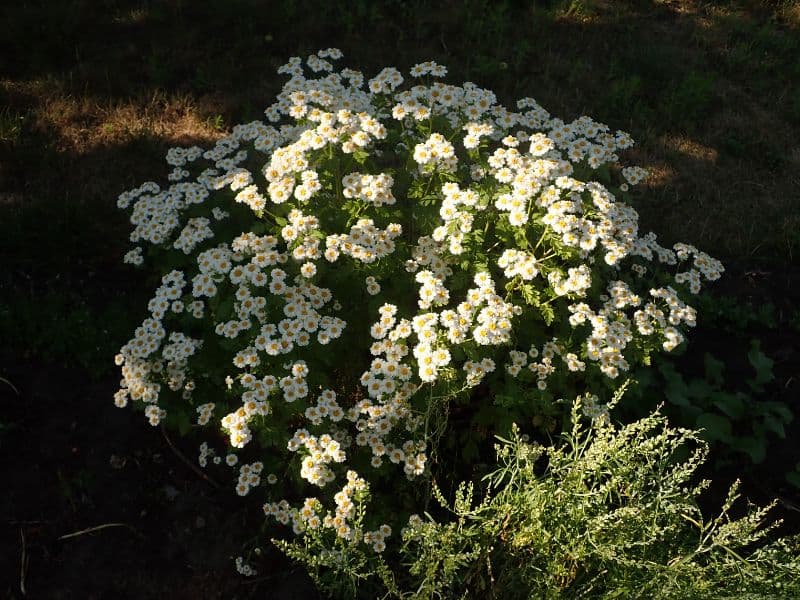
A systematic review focusing on the consumption of feverfew liquid extract, specifically formulations containing a minimum of 0.2% parthenolide, has validated its anti-inflammatory activity, capacity to inhibit histamine release, and potential as a chemotherapeutic agent through the suppression of microbial growth and cytotoxicity linked to the disruption of DNA replication. Nonetheless, given parthenolide’s significant potential as a skin sensitizer, its application in topical treatments is deemed unfeasible.
Further research explored the use of parthenolide-depleted feverfew extract in vitro (PD-feverfew) to mitigate the risk of allergic reactions and contact dermatitis associated with parthenolide. This investigation, which involved 1,200 participants, demonstrated clinical tolerance and affirmed that the removal of parthenolide does not compromise the extract’s antioxidant efficacy. The findings indicate that PD-feverfew reduced smoke- and UV-induced DNA damage, cellular apoptosis and inflammation.
Adverse effects
Long-term use of feverfew followed by abrupt discontinuation may induce a withdrawal syndrome featuring rebound headaches and muscle and joint pains. Feverfew may cause allergic reactions in those allergic to the daisy family, including contact dermatitis or swelling and numbness of the mouth. Other side effects have included gastrointestinal upset such as mild nausea, vomiting, abdominal pain, diarrhea, and flatulence, which are, fortunately mild and transient.
When the herb is chewed or taken orally it may cause mouth ulcers. Feverfew should not be taken by pregnant women. It may interact with blood thinners and increase the risk of bleeding, and also may interact with a variety of medications metabolized by the liver.
Find Where to Buy the Best Feverfew (Tanacetum parthenium)









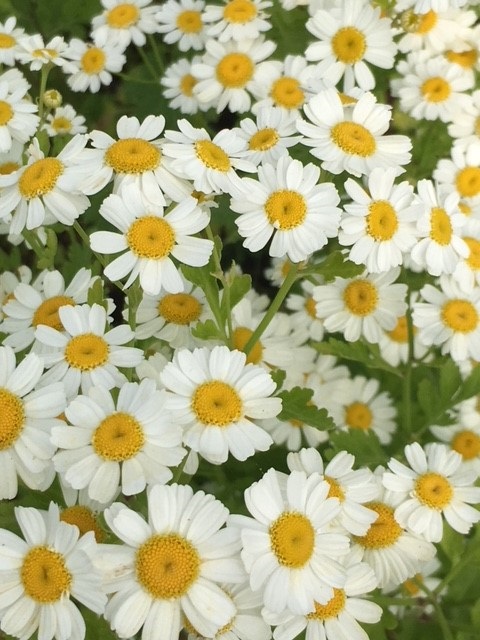








Leave a Reply